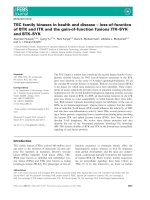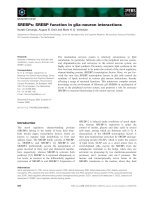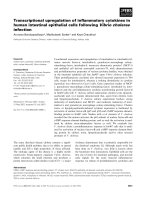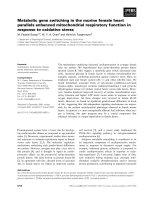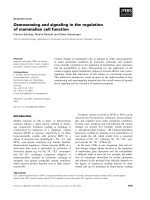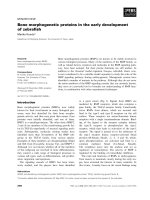Tài liệu Báo cáo khoa học: "Humor as Circuits in Semantic Networks" doc
Bạn đang xem bản rút gọn của tài liệu. Xem và tải ngay bản đầy đủ của tài liệu tại đây (1.31 MB, 6 trang )
Proceedings of the 50th Annual Meeting of the Association for Computational Linguistics, pages 150–155,
Jeju, Republic of Korea, 8-14 July 2012.
c
2012 Association for Computational Linguistics
Humor as Circuits in Semantic Networks
Igor Labutov
Cornell University
Hod Lipson
Cornell University
Abstract
This work presents a first step to a general im-
plementation of the Semantic-Script Theory
of Humor (SSTH). Of the scarce amount of
research in computational humor, no research
had focused on humor generation beyond sim-
ple puns and punning riddles. We propose
an algorithm for mining simple humorous
scripts from a semantic network (Concept-
Net) by specifically searching for dual scripts
that jointly maximize overlap and incongruity
metrics in line with Raskin’s Semantic-Script
Theory of Humor. Initial results show that a
more relaxed constraint of this form is capable
of generating humor of deeper semantic con-
tent than wordplay riddles. We evaluate the
said metrics through a user-assessed quality of
the generated two-liners.
1 Introduction
While of significant interest in linguistics and phi-
losophy, humor had received less attention in the
computational domain. And of that work, most re-
cent is predominately focused on humor recognition.
See (Ritchie, 2001) for a good review. In this pa-
per we focus on the problem of humor generation.
While humor/sarcasm recognition merits direct ap-
plication to the areas such as information retrieval
(Friedland and Allan, 2008), sentiment classifica-
tion (Mihalcea and Strapparava, 2006), and human-
computer interaction (Nijholt et al., 2003), the ap-
plication of humor generation is not any less sig-
nificant. First, a good generative model of humor
has the potential to outperform current discrimina-
tive models for humor recognition. Thus, ability to
!
Figure 1: Semantic circuit
generate humor will potentially lead to better humor
detection. Second, a computational model that con-
forms to the verbal theory of humor is an accessi-
ble avenue for verifying the psycholinguistic theory.
In this paper we take the Semantic Script Theory
of Humor (SSTH) (Attardo and Raskin, 1991) - a
widely accepted theory of verbal humor and build a
generative model that conforms to it.
Much of the existing work in humor generation
had focused on puns and punning riddles - hu-
mor that is centered around wordplay. And while
more recent of such implementations (Hempelmann
et al., 2006) take a knowledge-based approach that
is rooted in the linguistic theory (SSTH), the con-
straint, nevertheless, significantly limits the poten-
tial of SSTH. To our knowledge, our work is the first
attempt to instantiate the theory at the fundamental
level, without imposing constraints on phonological
similarity, or a restricted set of domain oppositions.
150
1.1 Semantic Script Theory of Humor
The Semantic Script Theory of Humor (SSTH) pro-
vides machinery to formalize the structure of most
types of verbal humor (Ruch et al., 1993). SSTH
posits an existence of two underlying scripts, one of
which is more obvious than the other. To be humor-
ous, the underlying scripts must satisfy two condi-
tions: overlap and incongruity. In the setup phase of
the joke, instances of the two scripts are presented
in a way that does not give away the less obvious
script (due to their overlap). In the punchline (res-
olution), a trigger expression forces the audience
to switch their interpretation to the alternate (less
likely) script. The alternate script must differ sig-
nificantly in meaning (be incongruent with the first
script) for the switch to have a humorous effect. An
example below illustrates this idea (S
1
is the obvi-
ous script, and S
2
is the alternate script. Bracketed
phrases are labeled with the associated script).
‘‘Is the [doctor]
S
1
at home?’’
the [patient]
S
1
asked in his
[bronchial]
S
1
[whisper]
S
2
. ‘‘No,’’
the [doctor’s]
S
1
[young and pretty
wife]
S
2
[whispered]
S
2
in reply.
[‘‘Come right in.’’]
S
2
(Raskin, 1985)
2 Related Work
Of the early prototypes of pun-generators, JAPE
(Binsted and Ritchie, 1994), and its successor,
STANDUP (Ritchie et al., 2007), produced ques-
tion/answer punning riddles from general non-
humorous lexicon. While humor in the generated
puns could be explained by SSTH, the SSTH model
itself was not employed in the process of generation.
Recent work of Hempelmann (2006) comes closer
to utilizing SSTH. While still focused on generating
puns, they do so by explicitly defining and applying
script opposition (SO) using ontological semantics.
Of the more successful pun generators are systems
that exploit lexical resources. HAHAcronym (Stock
and Strapparava, 2002), a system for generating hu-
morous acronyms, for example, utilizes WordNet-
Domains to select phonologically similar concepts
from semantically disparate domains. While the de-
gree of humor sophistication from the above systems
varies with the sophistication of the method (lexi-
cal resources, surface realizers), they all, without ex-
ception, rely on phonological constraints to produce
script opposition, whereas a phonological constraint
is just one of the many ways to generate script op-
position.
3 System overview
ConceptNet (Liu and Singh, 2004) lends itself as an
ideal ontological resource for script generation. As a
network that connects everyday concepts and events
with a set of causal and spatial relationships, the re-
lational structure of ConceptNet parallels the struc-
ture of the fabula model of story generation - namely
the General Transition Network (GTN) (Swartjes
and Theune, 2006). As such, we hypothesize that
there exist paths within the ConceptNet graph that
can be represented as feasible scripts in the sur-
face form. Moreover, multiple paths between two
given nodes represent overlapping scripts - a nec-
essary condition for verbal humor in SSTH. Given
a semantic network hypergraph G = (V, L) where
V ∈ Concepts, L ∈ Relations, we hypothesize
that it is possible to search for script-pairs as seman-
tic circuits that can be converted to a surface form
of the Question/Answer format. We define a circuit
as two paths from root A that terminate at a common
node B. Our approach is composed of three stages -
(1) we build a script model (SM) that captures likely
transitions between concepts in a surface-realizable
sequence, (2) The script model (SM) is then em-
ployed to generate a set of feasible circuits from a
user-specified root node through spreading activa-
tion, producing a set of ranked scripts. (3) Ranked
scripts are converted to surface form by aligning a
subset of its concepts to natural language templates
of the Question/Answer form. Alignment is per-
formed through a scoring heuristic which greedily
optimizes for incongruity of the surface form.
3.1 Script model
We model a script as a first order Markov chain of
relations between concepts. Given a seed concept,
depth-first search is performed starting from the root
concept, considering all directed paths terminating
at the same node as candidates for feasible script
pairs. Most of the found semantic circuits, however,
151
do not yield a meaningful surface form and need
to be pruned. Feasible circuits are learned in a su-
pervised way, where binary labels assign each can-
didate circuit one of the two classes {feasible,
infeasible} (we used 8 seed concepts, with 300
generated circuits for each concept). Learned tran-
sition probabilities are capable of capturing primi-
tive stories with events, consequences, as well as
appropriate qualifiers of certainty, time, size, loca-
tion. Given a chain of concepts S (from hereon re-
ferred to as a script) c
1
, c
2
c
n
, we obtain its likeli-
hood Pr(S) =
Pr(r
ij
|r
jk
), where r
ij
and r
jk
are
directed relations joining concepts < c
i
, c
j
>, and
< c
j
, c
k
> respectively, and the conditionals are
computed from the maximum likelihood estimate of
the training data.
3.2 Semantic overlap and spreading activation
While the script model is able to capture seman-
tically meaningful transitions in a single script, it
does not capture inter-script measures such as over-
lap and incongruity. We employ a modified form
of spreading activation with fan-out and path con-
straints to find semantic circuits while maximizing
their semantic overlap. Activation starts at the user-
specified root concept and radiates along outgoing
edges. Edge pairs are weighted with their respective
transition probabilities Pr(r
ij
|r
jk
) and a decay fac-
tor γ < 1 to penalize for long scripts. An additional
fan-out constraint penalizes nodes with a large num-
ber of outgoing edges (concepts that are too gen-
eral to be interesting). The weight of a current node
w(c
i
) is given by:
w(c
i
) =
c
k
∈f
in
(c
j
)
c
j
∈f
in
(c
i
)
Pr(r
ij
|r
jk
)
|f
out
(c
i
)|
γw(c
j
) (1)
Termination condition is satisfied when the activa-
tion weights fall below a threshold (loop checking
is performed to prevent feedback). Upon termina-
tion, nodes are ranked by their activation weight, and
for each node above a specified rank, a set of paths
(scripts) S
k
∈ S is scored according to:.
φ
k
= |S
k
| log γ +
|S
k
|
i
log Pr
k
(r
i+1
|r
i
) (2)
where φ
k
is decay-weighted log-likelihood of script
S
k
in a given circuit and |S
k
| is the length of script
A
Q
Q
Q
S
1
S
2
C
1
C
2
Figure 2: Question(Q) and Answer(A) concepts within
the semantic circuit. Areas C
1
and C
2
represent differ-
ent semantic clusters. Note that the answer(A) concept is
chosen from a different cluster than the question concepts
S
k
(number of nodes in the k
th
chain). A set of
scripts S with the highest scores in the highest rank-
ing circuits represent scripts that are likely to be fea-
sible and display a significant amount of semantic
overlap within the circuit.
3.3 Incongruity and surface realization
The task is to select a script pair {S
i
, S
j
i = j} ∈
S × S and a set of concepts C ∈ S
i
∪ S
j
that will
align with some surface template, while maximiz-
ing inter-script incongruity. As a measure of con-
cept incongruity, we hierarchically cluster the entire
ConceptNet using a Fast Community Detection al-
gorithm (Clauset et al., 2004). We observe that clus-
ters are generated for related concepts, such as reli-
gion, marriage, computers. Each template presents
up to two concepts {c
1
∈ S
i
, c
2
∈ S
j
i = j} in the
question sentence (Q in Figure 2), and one concept
c
3
∈ S
i
∪ S
j
in the answer sentence (A in Figure
2). The motivation of this approach is that the two
concepts in the question are selected from two dif-
ferent scripts but from the same cluster, while the an-
swer concept is selected from one of the two scripts
and from a different cluster. The effect the generated
two-liner produces is that of a setup and resolution
(punchline), where the question intentionally sets up
two parallel and compatible scripts, and the answer
triggers the script switch. Below are the top-ranking
two-liners as rated by a group of fifteen subjects
(testing details in the next section). Each concept
is indicated in brackets and labeled with the script
from which the concept had originated:
Why does the [priest]
root
[kneel]
S
1
in
[church]
S
2
? Because the [priest]
root
wants to [propose woman]
S
1
152
Why does the [priest]
root
[drink
coffee]
S
1
and [believe god]
S
2
?
Because the [priest]
root
wants to
[wake up]
S
1
Why is the [computer]
root
[hot]
S
1
in
[mit]
S
2
? Because [mit]
S
2
is [hell]
S
2
Why is the [computer]
root
in
[hospital]
S
1
? Because the
[computer]
root
has [virus]
S
2
4 Results
We evaluate the generated two-liners by presenting
them as human-generated to remove possible bias.
Fifteen subjects (N = 15, 12 male, 3 female - grad-
uate students in Mechanical Engineering and Com-
puter Science departments) were presented 48 high-
est ranking two-liners, and were asked to rate each
joke on the scale of 1 to 4 according to four cat-
egories: hilarious (4), humorous (3), not humor-
ous (2), nonsense(1). Each two-liner was generated
from one of the three root categories (12 two-liners
in each): priest, woman, computer, robot, and to
normalize against individual humor biases, human-
made two-liners were mixed in in the same cate-
gories. Two-liners generated by three different al-
gorithms were evaluated by each subject:
Script model + Concept clustering (SM+CC)
Both script opposition and incongruity are
favored through spreading activation and
concept clustering.
Script model only (SM) No concept clustering is
employed. Adherence of scripts to the script
model is ensured through spreading activation.
Baseline Loops are generated from a user-specified
root using depth first search. Loops are pruned
only to satisfy surface templates.
We compare the average scores between the two-
liners generated using both the script model and con-
cept clustering (SM+CC) (MEAN=1.95, STD=0.27)
and the baseline (MEAN=1.06, STD=0.58). We
observe that SM+CC algorithm yields significantly
higher-scoring two-liners (one-sided t-test) with
95% confidence.
0
20
40
60
80
100
Baseline SM SM+CC Human
% (N=15)
Nonsense
Non-
humorous
Humorous
Hilarious
Figure 3: Human blind evaluation of generated two-liners
We observe that the fraction of non-humorous and
nonsensical two-liners generated is still significant.
Many non-humorous (but semantically sound) two-
liners were formed due to erroneous labels on the
concept clusters. While clustering provides a fun-
damental way to generate incongruity, noise in the
ConceptNet often leads of cluster overfitting, and as-
signs related concepts into separate clusters.
Nonsensical two-liners are primarily due to the in-
consistencies in POS with relation types within the
ConceptNet. Because our surface form templates
assume a part of speech, or a phrase type from the
ConceptNet specification, erroneous entries produce
nonsensical results. We partially address the prob-
lem by pruning low-scoring concepts (ConceptNet
features a SCORE attribute reflecting the number of
user votes for the concept), and all terminal nodes
from consideration (nodes that are not expanded by
users often indicate weak relationships).
5 Future Work
Through observation of the generated semantic
paths, we note that more complex narratives, beyond
questions/answer forms can be produced from the
ConceptNet. Relaxing the rigid template constraint
of the surface realizer will allow for more diverse
types of generated humor. To mitigate the fragility
of concept clustering, we are augmenting the Con-
ceptNet with additional resources that provide do-
main knowledge. Resources such as SenticNet
(WordNet-Affect aligned with ConceptNet) (Cam-
bria et al., 2010b), and WordNet-Domains (Kolte
and Bhirud, 2008) are both viable avenues for robust
concept clustering and incongruity generation.
153
Acknowledgement
This paper is for my Babishan - the most important
person in my life.
Huge thanks to Max Kelner - those everyday teas at
Mattins and continuous inspiration.
This work was supported in part by NSF CDI Grant
ECCS 0941561. The content of this paper is solely
the responsibility of the authors and does not neces-
sarily represent the official views of the sponsoring
organizations.
References
S. Attardo and V. Raskin. 1991. Script theory revis (it)
ed: Joke similarity and joke representation model. Hu-
mor: International Journal of Humor Research; Hu-
mor: International Journal of Humor Research.
K. Binsted and G. Ritchie. 1994. A symbolic description
of punning riddles and its computer implementation.
Arxiv preprint cmp-lg/9406021.
K. Binsted, A. Nijholt, O. Stock, C. Strapparava,
G. Ritchie, R. Manurung, H. Pain, A. Waller, and
D. O’Mara. 2006. Computational humor. Intelligent
Systems, IEEE, 21(2):59–69.
K. Binsted. 1996. Machine humour: An implemented
model of puns.
E. Cambria, A. Hussain, C. Havasi, and C. Eckl. 2010a.
Senticspace: visualizing opinions and sentiments in
a multi-dimensional vector space. Knowledge-Based
and Intelligent Information and Engineering Systems,
pages 385–393.
E. Cambria, R. Speer, C. Havasi, and A. Hussain. 2010b.
Senticnet: A publicly available semantic resource for
opinion mining. In Proceedings of the 2010 AAAI Fall
Symposium Series on Commonsense Knowledge.
A. Clauset, M.E.J. Newman, and C. Moore. 2004. Find-
ing community structure in very large networks. Phys-
ical review E, 70(6):066111.
F. Crestani. 1997. Retrieving documents by constrained
spreading activation on automatically constructed hy-
pertexts. In EUFIT 97-5th European Congress on In-
telligent Techniques and Soft Computing. Germany.
Citeseer.
L. Friedland and J. Allan. 2008. Joke retrieval: recogniz-
ing the same joke told differently. In Proceeding of the
17th ACM conference on Information and knowledge
management, pages 883–892. ACM.
C.F. Hempelmann, V. Raskin, and K.E. Triezenberg.
2006. Computer, tell me a joke but please make it
funny: Computational humor with ontological seman-
tics. In Proceedings of the Nineteenth International
Florida Artificial Intelligence Research Society Con-
ference, Melbourne Beach, Florida, USA, May 11, vol-
ume 13, pages 746–751.
S.G. Kolte and S.G. Bhirud. 2008. Word sense disam-
biguation using wordnet domains. In Emerging Trends
in Engineering and Technology, 2008. ICETET’08.
First International Conference on, pages 1187–1191.
IEEE.
H. Liu and P. Singh. 2004. Conceptneta practical com-
monsense reasoning tool-kit. BT technology journal,
22(4):211–226.
R. Mihalcea and C. Strapparava. 2006. Learning to laugh
(automatically): Computational models for humor
recognition. Computational Intelligence, 22(2):126–
142.
M.E.J. Newman. 2006. Modularity and community
structure in networks. Proceedings of the National
Academy of Sciences, 103(23):8577–8582.
A. Nijholt, O. Stock, A. Dix, and J. Morkes. 2003. Hu-
mor modeling in the interface. In CHI’03 extended ab-
stracts on Human factors in computing systems, pages
1050–1051. ACM.
V. Raskin. 1998. The sense of humor and the truth. The
Sense of Humor. Explorations of a Personality Char-
acteristic, Berlin: Mouton De Gruyter, pages 95–108.
G. Ritchie, R. Manurung, H. Pain, A. Waller, R. Black,
and D. OMara. 2007. A practical application of com-
putational humour. In Proceedings of the 4th. Inter-
national Joint Workshop on Computational Creativity,
London, UK.
G. Ritchie. 2001. Current directions in computational
humour. Artificial Intelligence Review, 16(2):119–
135.
W. Ruch, S. Attardo, and V. Raskin. 1993. Toward an
empirical verification of the general theory of verbal
humor. Humor: International Journal of Humor Re-
search; Humor: International Journal of Humor Re-
search.
J. Savoy. 1992. Bayesian inference networks and spread-
ing activation in hypertext systems. Information pro-
cessing & management, 28(3):389–406.
S. Spagnola and C. Lagoze. 2011. Edge dependent
pathway scoring for calculating semantic similarity in
conceptnet. In Proceedings of the Ninth International
Conference on Computational Semantics, pages 385–
389. Association for Computational Linguistics.
O. Stock and C. Strapparava. 2002. Hahacronym:
Humorous agents for humorous acronyms. Stock,
Oliviero, Carlo Strapparava, and Anton Nijholt. Eds,
pages 125–135.
I. Swartjes and M. Theune. 2006. A fabula model for
emergent narrative. Technologies for Interactive Digi-
tal Storytelling and Entertainment, pages 49–60.
154
J.M. Taylor and L.J. Mazlack. 2004. Humorous word-
play recognition. In Systems, Man and Cybernetics,
2004 IEEE International Conference on, volume 4,
pages 3306–3311. IEEE.
J. Taylor and L. Mazlack. 2005. Toward computational
recognition of humorous intent. In Proceedings of
Cognitive Science Conference, pages 2166–2171.
J.M. Taylor. 2009. Computational detection of humor: A
dream or a nightmare? the ontological semantics ap-
proach. In Proceedings of the 2009 IEEE/WIC/ACM
International Joint Conference on Web Intelligence
and Intelligent Agent Technology-Volume 03, pages
429–432. IEEE Computer Society.
155


